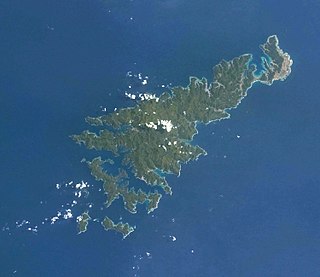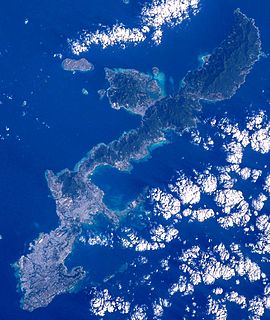Related Research Articles

The Sakishima Islands are an archipelago located at the southernmost end of the Japanese Archipelago. They are part of the Ryukyu Islands and include the Miyako Islands and the Yaeyama Islands. The islands are administered as part of Okinawa Prefecture, Japan.

Gusuku often refers to castles or fortresses in the Ryukyu Islands that feature stone walls. However, the origin and essence of gusuku remain controversial. In the archaeology of Okinawa Prefecture, the Gusuku period refers to an archaeological epoch of the Okinawa Islands that follows the shell-mound period and precedes the Sanzan period, when most gusuku are thought to have been built. Many gusuku and related cultural remains on Okinawa Island have been listed by UNESCO as World Heritage Sites under the title Gusuku Sites and Related Properties of the Kingdom of Ryukyu.

The Ryukyuan languages, also Lewchewan or Luchuan, are the indigenous languages of the Ryukyu Islands, the southernmost part of the Japanese archipelago. Along with the Japanese language and the Hachijō language, they make up the Japonic language family.

Amami Ōshima, also known as Amami, is the largest island in the Amami archipelago between Kyūshū and Okinawa. It is one of the Satsunan Islands.

The Amami language or languages, also known as Amami Ōshima or simply Ōshima, is a Ryukyuan language spoken in the Amami Islands south of Kyūshū. The southern variety of Setouchi township may be a distinct language more closely related to Okinawan than it is to northern Ōshima.

The Amami Islands is an archipelago in the Satsunan Islands, which is part of the Ryukyu Islands, and is southwest of Kyushu. Administratively, the group belongs to Kagoshima Prefecture, Japan. The Geospatial Information Authority of Japan and the Japan Coast Guard agreed on February 15, 2010, to use the name of Amami-guntō (奄美群島) for the Amami Islands. Prior to that, Amami-shotō (奄美諸島) was also used. The name of Amami is probably cognate with Amamikyu (阿摩美久), the goddess of creation in the Ryukyuan creation myth.

The Ryukyu Islands, also known as the Nansei Islands or the Ryukyu Arc, are a chain of Japanese islands that stretch southwest from Kyushu to Taiwan: the Ōsumi, Tokara, Amami, Okinawa, and Sakishima Islands, with Yonaguni the westernmost. The larger are mostly high islands and the smaller mostly coral. The largest is Okinawa Island.

The invasion of Ryukyu by forces of the Japanese feudal domain of Satsuma took place from March to May of 1609, and marked the beginning of the Ryukyu Kingdom's status as a vassal state under the Satsuma domain. The invasion force was met with stiff resistance from the Ryukyuan military on all but one island during the campaign. Ryukyu would remain a vassal state under Satsuma, alongside its already long-established tributary relationship with China, until it was formally annexed by Japan in 1879 as the Okinawa Prefecture.

Kikaijima is one of the Satsunan Islands, classed with the Amami archipelago between Kyūshū and Okinawa.
Shima-uta is a genre of songs originating from the Amami Islands, Kagoshima Prefecture of southwestern Japan. It became known nationwide in the 2000s with the success of young pop singers from Amami Ōshima such as Hajime Chitose and Atari Kōsuke.
The Kikai language is spoken on Kikai Island, Kagoshima Prefecture of southwestern Japan. It is debated whether it is a single dialect cluster. Regardless, all Kikai dialects are members of the Amami–Okinawan languages, which are part of the Japonic languages.
Ryukyuan music, also called Nanto music, is an umbrella term that encompasses diverse musical traditions of the Amami, Okinawa, Miyako and Yaeyama Islands of southwestern Japan. The term of "Southern Islands" is preferred by scholars in this field. The word "Ryūkyū" originally referred to Okinawa Island and has a strong association with the highly centralized Ryukyu Kingdom based on Okinawa Island and its high culture practiced by the samurai class in its capital Shuri. By contrast, scholars who cover a much broader region lay emphasis on folk culture.
The Northern Ryukyuan languages are a group of languages spoken in the Amami Islands, Kagoshima Prefecture and the Okinawa Islands, Okinawa Prefecture of southwestern Japan. It is one of two primary branches of the Ryukyuan languages, which are then part of the Japonic languages. The subdivisions of Northern Ryukyuan are a matter of scholarly debate.
The Okinoerabu dialect cluster, also Oki-no-Erabu, is a dialect cluster spoken on Okinoerabu Island, Kagoshima Prefecture of southwestern Japan. It is part of the Amami–Okinawan languages, which are part of the Japonic languages.

Amami Guntō National Park is a national park in Kagoshima Prefecture, Japan. Established in 2017, the park comprises a land area of 42,181 ha and a sea area of 33,082 ha. The national park includes areas of these islands: Tokunoshima, Kikai, Amami, Yoron, Okinoerabujima, Uke Island, Kakeromajima and Yoroshima.

The Second Shō dynasty was the last dynasty of the Ryukyu Kingdom from 1469 to 1879, ruled by the Second Shō family under the title of King of Chūzan. This family took the family name from the earlier rulers of the kingdom, the first Shō family, even though the new royal family has no blood relation to the previous one. Until the abolition of Japanese peerage in 1947, the head of the family was given the rank of marquess while several cadet branches held the title of baron.

Okinawa (沖縄) is a name with multiple referents. The endonym prototypically refers to Okinawa Island in southwestern Japan. Today it can cover some surrounding islands and, more importantly, can refer to Okinawa Prefecture, a much larger administrative division of Japan, although the people from the Miyako and Yaeyama Islands still feel a strong sense of otherness to Okinawa.
Amami Japanese is a variety of the Japanese language spoken on the island of Amami Ōshima. Its native term Ton-futsūgo means "potato standard". Much like Okinawan Japanese, it's a descendant of Standard Japanese but with influences from the traditional Ryukyuan languages.
The Amami reversion movement was a sociopolitical movement that called for the return of the Amami Islands from the U.S. military occupation to Japanese administration. It was mainly led by two groups, (1) the Fukkyō, or Amami Ōshima Nihon Fukki Kyōgikai in the Amami Islands, and (2) the Tokyo-based Amami Rengō, or Zenkoku Amami Rengō Sōhonbu.

Amami-Ōshima Island, Tokunoshima Island, northern part of Okinawa Island, and Iriomote Island (奄美大島、徳之島、沖縄島北部及び西表島) is a serial UNESCO World Heritage Site consisting of five component parts on four Japanese islands in the Ryukyu Chain of the Nansei Islands. The site was selected in terms of biodiversity for having a diverse ecosystem of plant and animal species that are unique to the region.
References
- ↑ Sumita Hiroshi 純田宏 (2005). "Amami guntō no myōji ni tsuite" 奄美群島の名字について. In Amami-gaku kankō iinkai 「奄美学」刊行委員会 (ed.). Amami-gaku奄美学 (in Japanese). Nanpou Shinsha. pp. 351–371.
- ↑ Prior to 1780, gōshi-kaku (郷士格) was known as tojōshujū-kaku (外城衆中格). See (Yuge:2005)
- 1 2 3 4 Yuge Masami 弓削政己 (2005). "Amami no ichiji myōji to gōshikaku ni tsuite" 奄美の一字名字と郷士格について. In Amami-gaku kankō iinkai 「奄美学」刊行委員会 (ed.). Amami-gaku奄美学 (in Japanese). Nanpou Shinsha. pp. 318–350.
- ↑ Yuge Masami 弓削政己 (2004). "Amami kara mita Satsuma to Ryūkyū" 奄美から見た薩摩と琉球. In Kagoshima Junshin Joshi Daigaku Kokusai Bunka Kenkyū Sentā 鹿児島純心女子大学国際文化研究センター (ed.). Shin-Satsuma-gaku 3: Satsuma Amami Ryūkyū新薩摩学3: 薩摩・奄美・琉球 (in Japanese). Nanpou Shinsha. pp. 149–169.
- ↑ "jaanunaa (ヤーヌナー)". Amami Dialect Dictionary. Okinawa Center of Language Study. Retrieved November 13, 2011.
- ↑ "naa (ナー)". Amami Dialect Dictionary. Okinawa Center of Language Study. Archived from the original on 20 February 2020. Retrieved November 13, 2011.
- ↑ "nesena (ネセナ)". Amami Dialect Dictionary. Okinawa Center of Language Study. Archived from the original on 20 February 2020. Retrieved November 13, 2011.
- ↑ "warabïna (ワラブぃナ)". Amami Dialect Dictionary. Okinawa Center of Language Study. Archived from the original on 20 February 2020. Retrieved November 13, 2011.
- ↑ "azana (アザナ)". Amami Dialect Dictionary. Okinawa Center of Language Study. Archived from the original on 20 February 2020. Retrieved November 13, 2011.